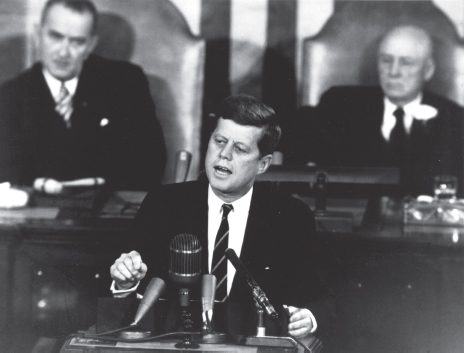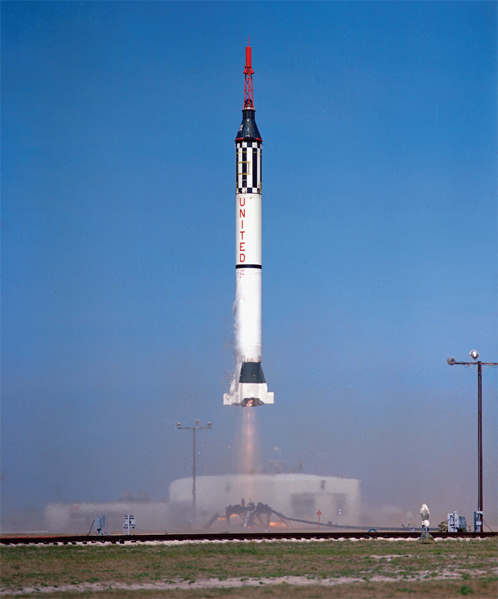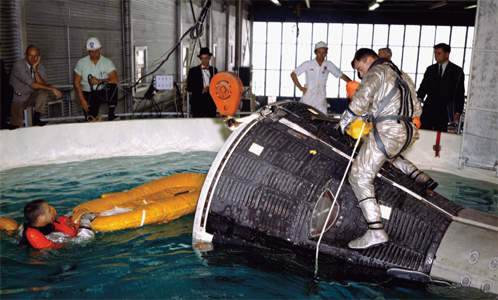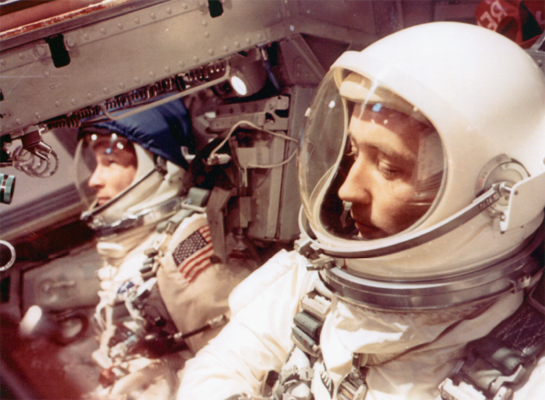
President John F. Kennedy speaks to Congress on May 25, 1961. In this speech, Kennedy said that he wanted the U.S. space program to land a man on the moon and return him safely to Earth before the end of the decade.
Ed White’s 1965 spacewalk was a much-needed triumph for American science. Four years earlier, the space program had been shaken by some costly launch failures. The Soviet Union’s program, by contrast, was roaring ahead. The gap widened again in the spring of 1961. On April 4, cosmonaut Yuri Gagarin became the first man to fly in space. His one-orbit flight, the experts agreed, gave the Soviets a big lead in the space race.
Seven weeks later, on May 25, 1961, President John F. Kennedy stepped forward to address the nation. By then, astronaut Alan Shepard had ridden his Mercury capsule into space. Unlike the Soviet flight, NASA’s planning had not allowed the capsule to orbit the earth. Shepard’s Freedom 7 splashed down after reaching an altitude of 116 miles (187 kilometers).1 Even so, President Kennedy used the flight to call for an all-out effort to meet the Soviet challenge. “I believe,” the young president told Congress, “that this nation should commit itself to achieving the goal, before this decade is out, of landing a man on the moon and returning him safely to earth.”2

President John F. Kennedy speaks to Congress on May 25, 1961. In this speech, Kennedy said that he wanted the U.S. space program to land a man on the moon and return him safely to Earth before the end of the decade.
At the time Kennedy spoke, Americans knew that their astronauts had logged only fifteen minutes in space. They also knew that the moon project would cost billions of dollars. In the end, that did not seem to matter. The stirring words inspired the nation to embark on a grand new adventure.
The people who worked on the moon program understood the great obstacles that lay ahead. Step by step, they had to build and test a spacecraft that could carry three astronauts into moon orbit. From there, two crew members would fly a lunar lander to the moon’s surface. When their moonwalk was finished, the lander would carry the astronauts back to their mother ship.
NASA began its quest by launching a series of space missions. Each flight was designed to build on the one before. In February 1962, millions cheered as John Glenn rode his Mercury 6 capsule to a three-orbit flight. Even though the Mercury program was far from finished, planners were looking ahead. Next up, they said, would be a larger spacecraft dubbed Mercury Mark II.
As the design took shape, NASA changed the Mark II’s name to “Gemini.” The name, Latin for “twins,” was inspired by the Gemini constellation and its twin stars, Castor and Pollux. In ancient times, the two stars had been known as the patron gods of voyagers. The “twins” label also took note of Gemini’s two-man crews. A foot longer and a foot wider than Mercury, Gemini’s cabin was a full 50 percent larger.3 No longer a “flying rock” like Mercury, the ship’s thrusters would allow it to maneuver in space. The design pleased the newly-chosen Gemini astronauts. The new spacecraft would allow them to do what they were paid to do—fly.4
Long before the first ship reached the launchpad, NASA had approved a bold set of goals. If all went as planned, the Gemini teams would tackle six tasks:
By the time Gemini 4 soared skyward, the project was closing in on all of these goals.

Early space missions in the moon program featured the Mercury rocket. Astronaut John Glenn rode his Mercury 6 capsule to a three-orbit flight. This photo shows an earlier launch of the Mercury-Redstone 2 carrying the chimpanzee Ham into space on January 31, 1961.
Training the Gemini Astronauts
NASA set high standards when it picked the Gemini astronauts. As with Mercury, only young, well-trained test pilots could hope to be chosen. Test pilots, NASA believed, had the skills needed to fly a spacecraft. Each candidate also had to have a college degree in engineering or one of the physical sciences. Without this training, the astronauts would find it hard to communicate with the project’s engineers and scientists. Height was also a factor. Because the cockpit was a tight fit, no one taller than six feet could apply. As a final hurdle, the volunteers had to pass a series of tough physical exams.6
In 1962, nine Gemini astronauts were chosen from over two hundred candidates. A second group of fourteen joined them a year later. Once chosen, the astronauts plunged into their rigorous training program. Long, tough sessions in flight simulators filled many of their days. The mock flights tested the astronauts’ responses to problems that could crop up during a mission. One moment, cabin pressure would drop. The next, the guidance system would break down. Astronaut Gus Grissom later wrote about the training, “All of us who flew the Gemini missions are pretty well agreed that the actual flights themselves seemed a lot easier than the simulations ‘flown’. . . on the ground.”7

Gemini astronauts John Young (right) and Gus Grissom (left) perform splashdown training exercises in a pool at Ellington Air Force Base, Texas. Grissom said the actual spaceflights were easier than the months of rigorous training that the astronauts had to undergo.
The training did not stop there. High-speed dives in Air Force transports gave the astronauts brief tastes of weightlessness. The teams also simulated life in zero gravity by working underwater in diving gear. Like the Mercury capsule, Gemini was designed to splash down at sea. If the spacecraft sank, the astronauts had to know how to escape. Once free of the ship, they had to prove that they could handle a life raft. Planners also worried that a mishap could force the spacecraft to land far off track. One week the astronauts were set down in the desert, the next in a jungle. Each new “crash” site tested their survival skills.
After long months of training, NASA chose the Gemini teams. No one would mistake the two Air Force majors picked to fly Gemini 4 for twins, but the men were a good fit. Born within six months of each other, James A. “Jim” McDivitt and Edward H. “Ed” White II were the same height. Each man had a wife named Pat. After meeting at the University of Michigan in 1959, both trained as test pilots. McDivitt had flown combat missions in Korea, but White had logged more hours of flying time. In their spare time, both men enjoyed handball, golf, and swimming. As White put it, “Jim and I have been following right along together.”8
In other ways, the two men were quite different. McDivitt was born in Chicago; White was born in San Antonio. The McDivitts had four children; the Whites had two. White came from a military family and was a West Point graduate. After serving in Korea, McDivitt had gone on to earn his college degree in aeronautics. As an astronaut, he played a key role in designing Gemini’s guidance system. White took on the task of making sure the control system had a “pilot’s touch.” In 1962, each simulator was fitted with a different control stick. Think ahead to the moon missions, White cautioned. Why should astronauts be forced to use one kind of stick to get there and a second to land the lunar module? The NASA designers listened—and equipped all American spacecraft with the same control stick.9

Ed White (left) and Jim McDivitt inside the Gemini 4 spacecraft wait for liftoff on June 3, 1965. With years of experience as test pilots behind them, the two Air Force officers were well qualified to fly the historic mission.
When White was twelve, his pilot father allowed him to fly an old T-6 trainer. That first turn at the controls helped shape the boy’s life. Years later, astronaut Ed White talked about the lesson he learned that day. “Set a goal,” he said, “believe in your heart and soul that you can achieve it—and then work to accomplish it.”10